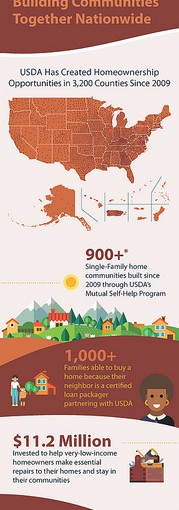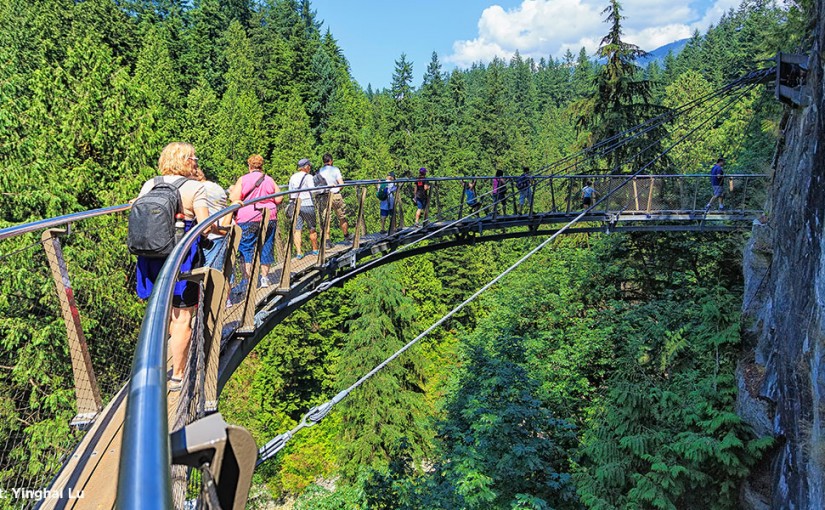Those in the longleaf pine range may be aware that the existing area of longleaf is but a scant remnant of its original distribution. Organizations and initiatives throughout the Southeastern US are actively working to restore and expand the acreage of this stately native tree. Variations in climate may present a new challenge to this […]![]()
Author: Site Owner
Building Communities Together Nationwide
Owning a home opens up a world of opportunities. A home is an asset that helps families finance education or a business. A home could be the reason you learn how to use a power drill, or the reason you start your first garden. Homeownership helps people become more financially literate all while connecting with their community in ways they may have never connected before.
Now that another Homeownership Month has come and gone, I would like to reflect on the strides the Obama Administration has made toward truly accessible rural homeownership for all. Since 2009 USDA Rural Development has made investments in affordable homeownership opportunities in 3,200 U.S. counties. These investments have benefitted more than 1 million people across the country.
Our Mutual Self-Help Grant Program has sponsored thousands of families and non-profit organizations in their quest to construct more than 900 communities across the nation. We’ve also invested $11.2 million in families and individuals who want to stay in their homes- and their communities- but needed help making essential repairs and improvements to their homes.
We couldn’t have done this on our own. We’ve worked with members of the Federal Family, non-profit and community organizations, and homeowners across the nation to reach as far and as deep as we could into rural America to find folks who needed us and needed our opportunities to move into the middle class, or simply preserve their family home.
With home builders, realtors, lenders, non-profits, community organizations, faith-based charities, and rural town leadership, USDA has helped many Americans change their lives. Thank you for celebrating Homeownership Month with us this year. We are so lucky to be Building Communities Together with so many organizations and people.
USDA is a Boon to Business in Boonville, NY; Higher Exports Thanks, in part, to Rural Development Program
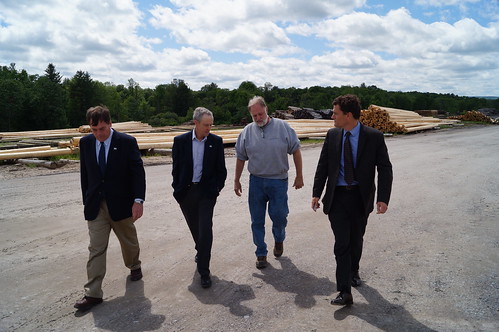
Administrator Sam Rikkers tours the lumber yard with CJ Logging Equipment and 3B Timber President, Mark Bourgeois.
Focusing on international markets, renewable energy and a community’s inherent assets, rural businesses find dynamic paths to prosperity. To see this in action, I headed to Boonville, New York.
Mark Bourgeois was born and raised in Boonville and today is President of CJ Logging Equipment and 3B Timber. A stable employer in the region, 3B Timer processes softwood trees on-site into utility poles. 3B Timber utilized Rural Development’s Business & Industry (B&I) loan guarantee to expand their operations. As Mark explained, his company now exports 80% of its poles to Canada, expanding international trade and supporting job creation in the region and state.
Boonville resident Randy Bowers is president and owner of Delta Hardwood Flooring and was eager to discuss his company’s exciting growth prospects. The recipient of two USDA Rural Energy for America Program (REAP) grants, Delta Hardwood purchased a biomass heating system and installed energy-efficient lighting in its large shop, which sat vacant for eight years before Bowers brought it back to life. Since its 2013 beginnings, Delta Hardwood has expanded its workforce from 20 to 40 with plans to double yet again.
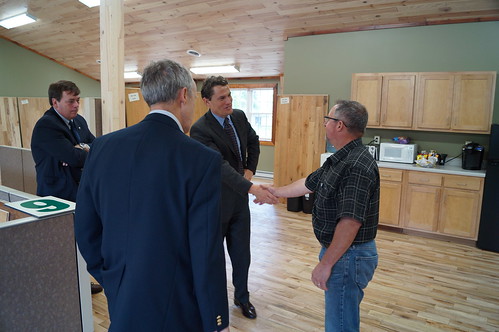
Randy Bowers of Delta Hardwood Flooring welcomes Administrator Sam Rikkers to the shop.
Boonville may not be known for its big buildings or crowded streets, but it does have some of the most delicious and pristine water you can drink. Owner-managers Paul Rayhill and Wade Abraham of Alder Creek Beverages recognized this incredible asset and took advantage of a USDA B&I loan guarantee to purchase Nirvana Inc., a struggling water brand from bankruptcy. Keeping Nirvana’s facilities operating, Rayhill and Abraham were able to save 50 jobs in a community that has seen persistent economic challenges, providing the community with a sense of sustainability.
These three businesses are examples of how rural communities are made better by the residents who work hard to maintain their stability. Rural businesses consistently keep Americans fed, clothed, housed, and warm while contributing these vital resources to the global market and USDA Rural Development is proud to help them succeed.
To read more about how USDA is getting results for US businesses looking to expand their trade potential, visit #USDAResults.

Administrator Sam Rikkers gets a behind-the-scenes look at the Alder Creek Beverages plant.
Does Your Smoked Brisket Make the Grade?
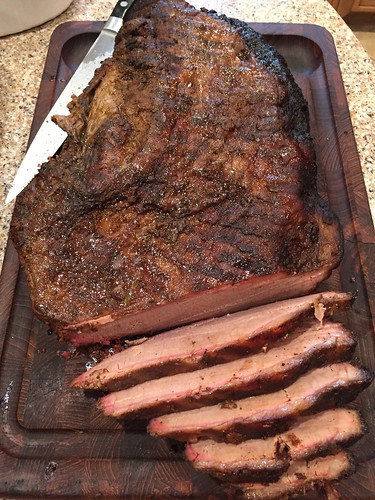
Official USDA quality grade labels provide assurance that your beef cuts meet specific quality thresholds that are individually assessed by a select staff of just over 140 skilled and highly trained USDA beef graders.
I live for barbeque season. There’s nothing like the satisfaction of getting that meat done just right, and nothing like the gratification that comes with sharing it with friends and family gathered on a sunny summer’s day.
When it comes to successful barbeque, I have a bit more skin in the game than most. You see, for me a quality eating experience at a family or community function isn’t just a personal goal – it’s a professional calling. My agency, USDA’s Agricultural Marketing Service (AMS), is committed to helping meat and poultry producers market their high quality products to consumers across the nation (and the world), and quality is the name of our game.
As the Deputy Administrator of the AMS Livestock, Poultry, and Seed Program, one of the programs I take considerable pride in is the quality standards and grades we develop and administer for beef products. We officially grade 18.4 billion pounds of beef each year according to these standards, supporting farmers and ranchers, and promoting an industry that is committed to quality products. These USDA beef quality grades also serve as a beacon to consumers looking for quality beef products to serve their families.
Success with barbeque meats isn’t always easy, but that’s what makes it fun. The classic beef brisket is a good example. A beautifully smoked beef brisket is sure to please and will keep people talking about your barbecue skills and gatherings for years to come. But it can be a challenge to get it right – it takes a combination of the right technique and the right ingredients – and no ingredient is more important than the brisket itself. So, take a tip from a professional: look for the USDA grade mark when you shop the meat section, and choose either a USDA Choice or USDA Prime brisket to ensure drool-inducing results!
Official USDA quality grades provide assurance that your beef cuts meet specific quality thresholds that are individually assessed by a select staff of just over 140 skilled and highly trained USDA beef graders. And, most importantly for all of you who love perfectly smoked meats as much as I do, shopping by these USDA beef quality grades are a sure-fire way to select the right beef for your ‘que.
So, go grab a USDA Choice or, if you want to splurge, a USDA Prime beef brisket, get your smoker stoked and ready, and prepare to bask in the eternal glory of a good barbeque you put together for those you care about!

Look for the USDA grade mark when you shop the meat section, and choose either a USDA Choice or USDA Prime brisket to get the best results.
Meet Our New Manager of Forest Conservation
 Justin Hynicka recently came to American Forests as our new manager of forest conservation. We’re excited for the experience, knowledge and new ideas he is bringing to the position and the organization — and we think you should be excited, too! From why he’s looking forward to helping further the American Forests’ mission to his favorite story from the field, read more about Justin.
Justin Hynicka recently came to American Forests as our new manager of forest conservation. We’re excited for the experience, knowledge and new ideas he is bringing to the position and the organization — and we think you should be excited, too! From why he’s looking forward to helping further the American Forests’ mission to his favorite story from the field, read more about Justin.
- Why did you choose to go into conservation?
I chose a career in forest conservation because of my love for the outdoors. I’ve spent a lot of time exploring the mountains throughout the continental United States, and as a recreational user of these areas, I felt compelled to help protect and restore them. I also studied ecosystem science as an undergraduate and graduate student. Forests are such interesting and beautiful places, and the more I learn about them the more excited I am to be working on their behalf. - What aspects of American Forests’ work are you most excited to be a part of?
I’m most excited to build partnerships with regional and local experts and forest advocates, to continue learning about the wide variety of forest ecosystem types around the world and how they function and, ultimately, contribute to their restoration, management and protection. - What do you think are the most significant challenges facing forests today?
Although deforestation is an ever present threat, maintaining forest health is a significant challenge due to the introduction of exotic pests, disease and climate change, among other factors. Fortunately, the decisions and investments we make in forest restoration and management today will have lasting benefits for future generations of people and wildlife. - Do you have a favorite story from your years in the field?
So far, my favorite trip in the field was a seven-day backpacking trip with a college friend in the Wind River Range, Wyo. It is quite the slog to the high-elevation lakes, but once you get there the scenery is spectacular. The lakes are cold, crystal clear and full of brook trout that were originally dropped into the lakes by plane during the 1920s and ‘30s to improve recreational fishing. Moose are abundant, and we saw several either crossing streams or gorging on herbaceous plants in wetlands. The highlight was camping near the Cirque of the Towers, which is a collection of sheer granite mountain peaks. The low point of the trip was a dead car battery (overhead light left on by yours truly) upon our return. - What is your favorite tree and why?
I have a few, but if I can only choose one, it has to be the American larch / tamarack (Larix laricina). It is unique because it is a deciduous conifer, which means that it has cones and needle-like leaves, like Christmas trees, but it has to regrow its leaves every year. When the leaves die in the fall, they turn bright yellow, and the new leaves in the spring are neon green. Also, who doesn’t love the circular pattern that the leaves grow in? The Strawberry Mountain Wilderness in eastern Oregon is a great place to see the American larch. A very close second is the shagbark hickory (Carya ovata).
REAP: Working Well in North Carolina
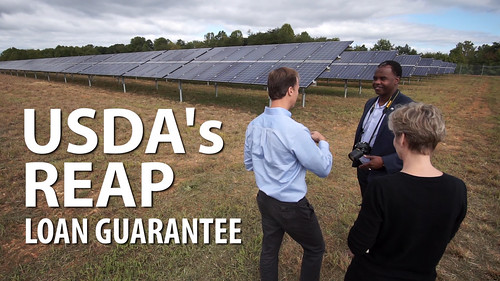
Joel Olson (left), President of O2 Energies, Inc. of North Carolina speaks with U.S. Department of Agriculture (USDA) staff in front of one of O2's solar projects. O2 worked with local North Carolina lender Surrey Bank & Trust and USDA Rural Development to finance the project.
USDA Rural Development’s Rural Energy for America Program, or REAP as we call it, is one of the flagship programs found in the energy title of the Farm Bill. Through REAP, USDA helps rural agricultural producers and small businesses improve their financial bottom line through increased energy efficiency and the development of renewable energy sources.
We wanted to share two great examples of this investment and development in North Carolina. In Mt. Airy, NC, local lenders took advantage of REAP’s loan guarantees to finance O2 Energies and build a solar farm that can provide up to 20% of the power needed by the community.
In Mt. Olive, NC, Doug Jernigan used the REAP program to turn his farm’s animal waste into energy. Generating power from poop, Mr. Jernigan puts the energy created back into the grid and offsets the costs associated his ranching operation.
Ultimately, through our loans, grants, and loan guarantees, the USDA REAP program is having a positive impact across the nation – not just by reducing fossil fuel impact and the carbon footprint of rural small businesses and producers – but by supporting jobs and economic investment in the rural communities we serve.
SNAP Farmers Market Webpage Streamlined, Updated
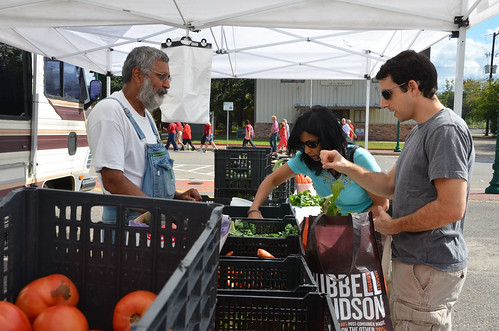
Shoppers explore the healthy food choices available at one of America’s farmers markets.
Expanding access to the healthy foods available at farmers markets and farm stands for those participating in the Supplemental Nutrition Assistance Program (SNAP) has been – and continues to be – a USDA priority. For several years now, we’ve provided funding to equip farmers markets and direct marketing farmers with the electronic technology they need to redeem SNAP benefits. The results speak for themselves. In 2008, there were only 753 SNAP-authorized markets and farmers. Today, that number has grown to more than 6,400 – more than eight times the number of SNAP-authorized farmers markets compared to when the Obama Administration first took office.
Recently SNAP updated our dedicated webpage to provide more current information to the ever increasing number of SNAP-authorized farmers markets and direct-marketing farmers participating in, or interested in participating in, the program. The redesigned webpage is now much easier to navigate, with links to key topics grouped and highlighted to streamline the search for information. Prospective farmers markets can now readily find out how they can be authorized to redeem program benefits and whether they qualify for free EBT equipment and about grants available at agencies throughout the U.S. Department of Agriculture. The site also includes a handy map that links to a spreadsheet, showing where SNAP-authorized farmers markets are located nationwide.
Farmers markets are playing a role in providing Americans with access to healthy foods. In a recent USDA study, almost 80 percent of farmers market shoppers mentioned access to high-quality fruits and vegetables as the reason for shopping at a farmers market and 65 percent of market shoppers perceived that fruits and vegetables were fresher at farmers markets than in other stores. Increased participation in SNAP by farmers markets is a win-win: Farmers experience an increase in customers; SNAP clients have better access to fresh and healthy food.
Each year, summer is a particularly welcome season. It’s a great time to get outside and enjoy the warm days and sunshine. And there’s no better place to do that than one of the thousands of farmers markets and farm stands located in communities across America. Visit our updated webpage today to find a SNAP-authorized farmers market near you.
USDA Launches a One Stop Shop for its “One Health” Approach to Zoonotic Threats

U.S. Department of Agriculture (USDA) Agriculture Research Service (ARS) graduate student Jacquelyn Escarcha inserts samples developed from cattle fecal waste into a solution that detects Salmonella on Dec. 6, 2002. USDA photo by Peggy Greb.
At USDA, we use a One Health approach that embraces the idea that problems arising at the intersection of the health of humans, animals, and the environment can be solved only through a coordinated multidisciplinary approach. This approach embraces the idea that a disease problem impacting the health of humans, animals, and the environment only can be solved through improved communication, cooperation, and collaboration across disciplines and institutions.
Because the One Health work that we do spans across many USDA agencies, we are launching a centralized web portal page to better help our stakeholders and the public better access our information. This page features USDA’s collective body of work on antimicrobial resistance (AMR), avian influenza and swine influenza as well as other One Health resources.
Using this collaborative approach, USDA, with its partners, seeks to maintain or reduce health risks to animals, humans, the environment and society. USDA has gained in-depth knowledge about, for example, zoonotic diseases (diseases that can move from animals to people or people to animals) and conditions such as AMR through its work on the agricultural production environment, animal health and food safety. Pathogens (disease causing organisms) can evolve and move from one organism to another and through the environment. Sometimes they mutate or evolve into more virulent strains, and sometimes they evolve to resist countermeasures such as the application of antibiotics. Investment in understanding the ecology of pathogens is necessary to develop strategies to address them.
Within USDA, the Animal and Plant Health Inspection Service, Agricultural Marketing Service, Agricultural Research Service, Economic Research Service, Food Safety and Inspection Service, Foreign Agricultural Service, National Agricultural Statistics Service and National Institutes of Food and Agriculture are all actively engaged in ongoing projects to better understand these and other complex issues at the animal, human and ecosystem interface.
USDA also partners with other U.S. government agencies – such as the U.S. Fish and Wildlife Service, U.S. Food and Drug Administration (FDA), the Centers for Disease Control and Prevention (CDC), the National Institutes of Health (NIH), the Environmental Protection Agency, and tribal Nations – to prevent and control problems that affect animal and plant health, human health and the environment. USDA emphasizes increased collaboration with other agencies to leverage infrastructures overseas to provide training and technical assistance on One Health issues.
USDA serves the nation through its commitment to producing wholesome and nutritious foods, preserving the safety of meat, poultry and egg products entering our country, through inspection services, and preserving the health, welfare and humane treatment of food animals while ensuring the health and safety of humans through our One Health partnerships.
UC Sheep Shearing School Prepares Students for Gainful Employment
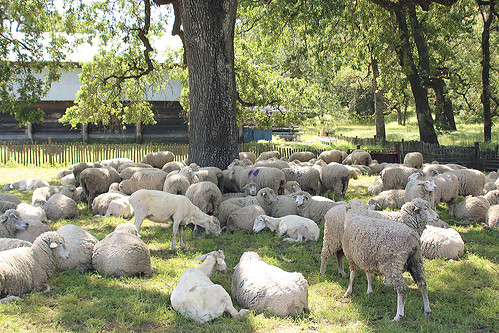
Unshorn sheep await their turn. Image courtesy of Jeanette Warnert
USDA’s National Institute of Food and Agriculture (NIFA) administers the Smith-Lever capacity grant program. The Smith–Lever Act established the cooperative extension services program administered through land-grant universities. Today, a guest blog from Jeanette Warnert, University of California Division of Agriculture and Natural Resources, tells us how this program supports a unique rural economic opportunity:
Sheep shearing is like a dance. It requires strength, flexibility, a tender touch, and the right moves. Once mastered, the skill can open the door to gratifying and high-paying seasonal work.
Sheep shearers will never be unemployed and never be poor. They can earn $50 to $100 per hour and can start a business with a $3,000 investment in equipment, says John Harper, University of California Cooperative Extension (UCCE) natural resources advisor in Mendocino County.
The need for skilled sheep shearers in California and other parts of the nation has prompted the University of California Hopland Research and Extension Center to host an annual sheep shearing school, the only intensive five-day course in the United States. Harper, the lead instructor and coordinator of sheep shearing school, is a 25-year veteran of UCCE. USDA’s National Institute of Food and Agriculture (NIFA) funds the program through a Smith-Lever capacity grant.
Although sheep shearing is traditionally a male occupation, women are also encouraged to take the course. In this low-to-the-ground endeavor, women have the advantage of a lower center of gravity. Strength is important, but so is the shearer’s flexibility, especially hip rotation. The sheep’s skin is very loose and the blades are powerful. Harper said the female students tend to be more cautious, which results in fewer nicks.
Beatrice Thomas, 41, is a typical student. A dancer, she left her Bay Area office job a year ago because, after sitting for 40 hours at a desk, her body ached. The finesse and physical work of sheep shearing, on the other hand, left her feeling vital.
The 5,200-acre Hopland Research and Extension Center is home to a flock of about 1,000 sheep, which provide opportunities for scientists to study their role in land management. They also serve as a ready supply of animals for prospective new shearers to learn the craft.
The instructors say learning to handle sheep calmly is the key to shearing success. Learning the finer points of shearing – footwork, positions, and getting the pattern down – come with practice.
The week-long sheep shearing school at Hopland are held in the spring. The class typically fills up within two hours of opening registration. Visit the UCCE Mendocino website for more information or to be notified when the next registration opens.
A Guide to Forest-Friendly Summer Vacationing
By Lindsay Seventko, Communications Intern
 Summer is here — the time to dive in sun-warmed water, to share strawberries piled high on shortcake and cream and to walk in the shade of a breathtaking forest. As you prepare for your summer getaway, keep in mind these tips on vacationing in a forest friendly way.
Summer is here — the time to dive in sun-warmed water, to share strawberries piled high on shortcake and cream and to walk in the shade of a breathtaking forest. As you prepare for your summer getaway, keep in mind these tips on vacationing in a forest friendly way.
Picking Your Destination
Whether you prefer to relax on an isolated beach, explore the culture and nightlife of a city or cool off by a mountain lake, a little digging can reveal more sustainable alternatives to the typical destination that will also allow you to explore some of the most beautiful forests in the world.
- Bald Head Island, North Carolina
For example, if you prefer a beach getaway, consider Bald Head Island, the southernmost of North Carolina’s cape islands. Accessed by ferry, the island requires biking, walking, or golf-carting to traverse. This not only saves carbon emissions while getting around, but also aids in relaxation and lets you explore the 10,000 acres of nature preserves on the island. Beaches stretch for 14 miles, a tidal creek winds through the salt marsh and a lush maritime forest stretches across the northeastern section of the island. Miles of trails serpentine among dogwoods, cedars, oaks and palms. American and Yaupon holly, wild olive and catbrier entangle beneath the canopy. Home to painted buntings, cardinals, and Carolina wrens, the forest also shelters migratory birds in the fall, including blue jays, catbirds, towhees, and twenty-two species of warblers. Sea turtles, foxes, otters and even alligators abound on the island.
- Lapa Rios, Costa Rica
If a tropical and exotic location is more your style, consider Lapa Rios in Costa Rica. While tourism in the rainforest usually means supporting unsustainable practices that harm the forest, the Lapa Rios ecolodge is a private 1,000-acre nature preserve that protects virgin rainforest from deforestation and serves as a model of sustainable ecotourism. The preserve is home to the nearly extinct Sangrillo Colorado tree, as well as jaguars, monkeys, poison dart frogs and toucans. Accommodations include screened, open air bungalows that immerse visitors in the sights and sounds of the breathtaking rainforest.
- Kicking Horse River Lodge, Canada
If a cool mountainous adventure is your preferred summer getaway, consider Kicking Horse River Lodge in Golden, British Columbia, Canada. Nestled between the Canadian Rockies and Purcell Mountains, the lodge uses geothermal and hydroelectric energy to shrink its footprint to a minimum. With accommodations ranging from dorm-style bunks to comfortable private rooms, the lodge can be a bargain hunter’s inexpensive launching pad for exploring the nearby national parks. Banff, the nearest national park, boasts turquoise lakes, jagged peaks and subalpine forest which are prime habitat for elk, moose, bald eagles, red-tailed hawks, grizzly and black bear and the threatened caribou.
Whatever your ideal summer plans include, look for cities that are known for their urban forests, golf courses that reuse their water, spas that favor natural products, hotels that have shrunk their footprint and, of course, nearby forests to explore.
Traveling to Your Destination
There’s an obvious rule of thumb when it comes to starting your vacation in a carbon friendly way — don’t fly if you can drive. But, if getting to your destination requires air travel, you can book flights that use larger and newer planes and don’t have layovers. One quick way to start an eco-friendly flying search is by using a search engine that includes the carbon footprint in the results shown, such as Gooby, where rankings are given for “quickest,” “cheapest,” “most popular” and most importantly, “greenest.”
While on Vacation
Once you’ve booked an eco-friendly destination and figured out how to get there with the smallest carbon footprint, remember to take a few steps to ensure that you continue to have a minimal impact on the environment.
Instead of taking a cab to recreation spots, explore the area on foot, bike or by public transportation. You will experience much more of the area and may even discover some hidden gems that are unlisted on Google results and unknown to the concierge.
Offer to reuse your towels and linens during your stay, or opt in to an environmental plan that your hotel offers. You can also turn off the thermostat when you’re not in your room, shower instead of bathing and explore local dining options that offer farm to table cuisine.
Coming Home
An important part of an eco-friendly vacation that often goes unmentioned is in what you bring home. Souvenirs are reminders of the extraordinary memories that were made and tokens of the culture or nature experienced. But often, tourist souvenirs don’t benefit the local community that was visited. Avoid purchasing products by big-name brands that can be found in shopping malls and airport terminals that won’t benefit the local community. Instead, search out locally and responsibly made products sold by small businesses, just be careful to avoid products made out of rare wood or animal parts that may have been harvested unsustainably or are a result of poaching.
There are endless enticing forests to explore this summer — find a destination that will allow you to experience the trees and wildlife of a beautiful tranquil forest in a more sustainable way.

